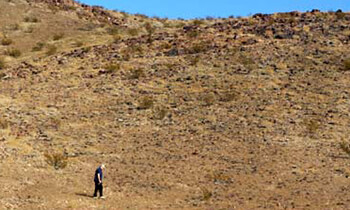Antelope Canyon
A Photographer's View of Antelope Canyon
Text and Photos by David Roberts, A.R.P.S.
The Four Corners area of the American Southwest lays claim to fame with its natural landmarks -- canyons, buttes, and desert -- combining their grandeur with that of Zion, Bryce and Arches National parks. Here is an area of scenic wonder, awe-inspiring in its raw, primitive beauty. Here is where I first discovered Antelope Canyon.
Just 15 miles from Lake Powell in Northern Arizona lies the town of Page, an ideal jumping off spot for investigating this area. I drove into the town in a leisurely fashion, taking the secondary roads, far less crowded and allowing for frequent stops as photo-ops came into view. This was my purpose in visiting Antelope canyon -- I was a photographer on a mission.

Antelope is a classic "slot" canyon -- walls sloping inward at the top, almost meeting, allowing only slivers of light to enter. Subterranean rivers have scoured them over the centuries and created intricate and extravagant shapes. As the walls are composed of strata compressed at different pressures in different directions. The flow of the ridges is poetry of line and form, constantly altering in a subtle way as the light changes.
Antelope, on Navajo tribal lands, is regarded as a sacred place by them, and the atmosphere that prevails, as in a place of worship, induces a feeling of reverence and hush in visitors. The Canyon is just a quarter of a mile long and 50 feet high, a winding pathway through its dimly lit wonder opening out into chambers here and there.
I strolled through, cataloguing prospective vantagepoints and at around 10:30 am, judging the light to be right, set my camera on a tripod and began shooting. Exposures are necessarily long, about 30 seconds, and at an aperture sufficiently small to ensure maximum depth of sharpness in the photo.
There is an inherent courtesy in photographers; anxious not to spoil someone else's shot. If they move into an area where a photograph is being taken, they will see your crouched, frozen position and, in consideration of the moment, will whisper, "is it okay to go through?"
Looking through the viewfinder defined the composition and, because the light is filtered in from the top, many of the shots were taken looking almost straight up. There was nothing in the shot to define scale, so photographs take on an abstract quality. Added to this were the multi-hued surfaces and it was indeed a visual feast. The grazing angle of the light enhanced the texture of the rock surface and it would be easy to become enthralled by what was seen in the viewfinder, so much as to forget to take any shots.
Several rolls of film later, I was done. With an aching back and stiff neck I headed back to my campground for a long hot shower and a stretch of aching muscles. It was difficult to leave this canyon with its mystical beauty, but I left with more than a memory. I had in my bag several rolls of film that held tangible results of the beauty I had witnessed. Even today my favorite, "Cresting Wave" adorns the wall of my den as a striking reminder of my solo adventure in Antelope Canyon.
 Photo Hints:
Photo Hints:
I have learned from bitter experience that having film processed while away on holiday can result in expensive and mediocre results.
Better to wait with that film and have it processed at a lab you know and trust.
Films used were Fuji 100 ASA Superia for prints and Fuji 200 ASA Sensia for slides. Cameras used were Minolta Maxxum 600si's with a Tamron 28 200 mm zoom. Exposures used the camera's 14-segment metering system, giving exposures with detail in both shadow and highlight areas.
Related DesertUSA Pages
Outdoor Recreation: Photography
The Anasazi Ruins of Grand Gulch
Native Americans: The Navajo
Places to Go in Utah
Share this page on Facebook:
The Desert Environment
The North American Deserts
Desert Geological Terms







